St. Catharines
| City of St. Catharines | |||||
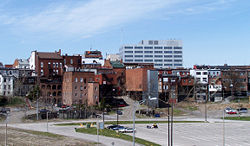 |
|||||
|
|||||
| Nickname(s): The Garden City | |||||
| Motto: Industry and Liberality | |||||
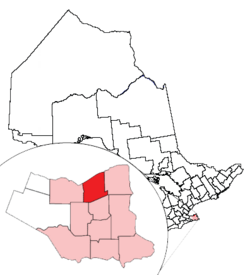 |
|||||
| Country | Canada |
||||
|---|---|---|---|---|---|
| Province | Ontario |
||||
| Region | Niagara | ||||
| Settled | 1783 | ||||
| Incorporated | 1845 (town) | ||||
| 1876 (city) | |||||
| Government | |||||
| - Mayor | Brian McMullan | ||||
| - Governing body | St. Catharines City Council | ||||
| - MPs | Rick Dykstra, Malcolm Allen | ||||
| - MPPs | Jim Bradley, Peter Kormos | ||||
| Area | |||||
| - City | 96.11 km² (37.1 sq mi) | ||||
| - Urban | 382.68 km² (147.8 sq mi) | ||||
| - Metro | 1,397.50 km² (539.6 sq mi) | ||||
| Elevation | 97.8 m (321 ft) | ||||
| Population (2006) | |||||
| - City | 131,989 (Ranked 33rd) | ||||
| - Density | 1,373.3/km² (3,556.8/sq mi) | ||||
| - Urban | 308,596 (Ranked 12th) | ||||
| - Urban Density | 545.02/km² (1,411.6/sq mi) | ||||
| - Metro | 390,317 (Ranked 12th) | ||||
| - Metro Density | 279.3/km² (723.4/sq mi) | ||||
| Source: Statistics Canada | |||||
| Time zone | Eastern (EST) (UTC-5) | ||||
| - Summer (DST) | EDT (UTC-4) | ||||
| Postal code | L2M-L2W, L0S | ||||
| Area code(s) | 905/289 | ||||
| Website: City of St. Catharines | |||||
St. Catharines (2006 population 131,989; metropolitan population 390,317) is the largest city in the Niagara Region and the sixth largest urban area in Ontario, Canada, with 97.11 square kilometres (37.5 sq mi) of land. It lies 51 kilometres (32 mi) south of Toronto across Lake Ontario and is 19 kilometres (12 mi) inland from the international boundary with the United States of America along the Niagara River. It is the northern entrance of the Welland Canal. Residents of St. Catharines are known as St. Catharinians.
St. Catharines carries the official nickname "The Garden City" due to its 1,000 acres (4 km²) of meticulously groomed parks, gardens and trails.
St. Catharines is situated in an excellent area for commerce and trade since it is conveniently located between Toronto and the United States of America. Manufacturing is the city's dominant industry, as noted by the heraldic motto, "Industry and Liberality". General Motors operates two plants in the city and until recently was the city's largest employer, an honour now held by the District School Board of Niagara. TRW operate a plant in the city, though in recent years employment has shifted from heavy industry and manufacturing to services.
St. Catharines lies on one of the main telecommunications backbones between Canada and the United States, and as a result a number of call centres operate in the city.
Contents |
History
The city was first settled by Loyalists in the 1780s. The first settlers, Sergeant Jacob Dittrick and Private John Hainer of Butler's Rangers, came to the area where Dick's Creek met Twelve Mile Creek. Dick's Creek was named after another early settler, Richard Pierpoint, a Black Loyalist who had been born in what is now Senegal and who had escaped slavery in New York to fight for the British Crown, hence his nickname of Captain Dick. This part of the settlement eventually became the centre of town. Native trails were used as travel routes, resulting in present day radial road pattern from the city centre.
The first business, a goods storehouse owned by Robert Hamilton, was established around 1783. The first mill, Crown Mills, was opened in 1786. The surrounding land was surveyed, and townships created, between 1787 and 1789. The small settlement was known at the time as "The Twelve".
In 1797, the first inn was built by Thomas Adams, located on the east side of Ontario Street next to what is now St. Paul Street. It became a community meeting place and stagecoach rest stop. In 1798, "The Twelve" became known as "Shipman's Corners", after the inn's new owner, Paul Shipman. According to some sources, St. Paul Street - the main route in and out of the city at the time - was named after him also.
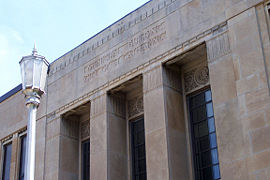
As Shipman's Corners, the town was visited by Laura Secord during the War of 1812, en route to warn James Fitzgibbon of the advancing Americans. She was travelling with her niece Elizabeth Secord, but Elizabeth was exhausted at that point and ceased her journey there. Laura Secord continued on to warn Fitzgibbon successfully.
In 1808, the first name "St. Catharines" appeared for the first time on a survey, named after Robert Hamilton's wife, Catharine Hamilton. In 1817, the post office was established with the name "St. Catherines" (sic), but by 1821, the name was officially "St. Catharines".
The first Welland Canal was constructed from 1824-33 behind what is now known as St. Paul Street, using Twelve Mile and Dick's Creek. William Hamilton Merritt worked tirelessly to promote the ambitious venture, both by raising funds and by enlisting government support. The canal established St. Catharines as the hub of commerce and industry for the Niagara Peninsula.
Merritt also played a role in making St. Catharines an important place of abolitionist activity. In 1855, the British Methodist Episcopal Church and Salem Chapel was established at the corner of Geneva and North streets, on land granted to the congregation by Merritt in the early 1840s. The area became known to escaped slaves as a place of "refuge and rest", and cemented it as a final terminus on the Underground Railroad for African American slaves. By the mid-1850s the population was about 6000, 800 of whom were "of African descent".[1] St. Catharines remains an important place in Black Canadian history.
The Town of St. Catharines was incorporated in 1845. St. Catharines was incorporated as a city in 1876.
Geography and climate
St. Catharines enjoys a unique micro-climate because of the moderating influence of Lake Ontario and Lake Erie and the sheltering effect of the Niagara Escarpment to the south. As a result, the city can record a large number of frost-free days in the winter. The summer season is predominantly warm, sometimes hot and humid, with the average temperature of 27 °C (81 °F) in July, but humidity is often high making feel more than 40 °C (104 °F) with the humidex factor.
| Month | Jan | Feb | Mar | Apr | May | Jun | Jul | Aug | Sep | Oct | Nov | Dec | Year |
|---|---|---|---|---|---|---|---|---|---|---|---|---|---|
| Average high °C | -0.5 | 0.3 | 5.4 | 12.2 | 19.4 | 24.3 | 27.1 | 25.9 | 21.5 | 14.9 | 8.3 | 2.4 | 13.4 |
| Average low °C | -7.7 | -7.4 | -3.2 | 2.1 | 7.8 | 13.3 | 16.4 | 15.7 | 11.6 | 5.6 | 0.9 | -4.5 | 4.2 |
| Precipitation mm | 63.1 | 51.9 | 67.9 | 77.8 | 74.9 | 82.5 | 73.6 | 72.1 | 91.5 | 68.5 | 75.5 | 74.2 | 873.6 |
| Average high °F | 31.1 | 32.5 | 41.7 | 54.0 | 66.9 | 75.7 | 80.8 | 78.6 | 70.7 | 58.8 | 46.9 | 36.3 | 56.1 |
| Average low °F | 18.1 | 18.9 | 26.2 | 35.8 | 46.0 | 55.9 | 61.5 | 60.3 | 52.9 | 42.1 | 33.6 | 23.9 | 39.6 |
| Precipitation inches | 2.48 | 2.04 | 2.67 | 3.06 | 2.95 | 3.25 | 2.90 | 2.84 | 3.60 | 2.70 | 2.97 | 2.92 | 34.39 |
| Source: Environment Canada[2] January 2006 | |||||||||||||
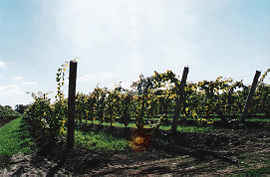
The complex and extensive glacial history of the Niagara Peninsula has resulted in similarly complex soil stratigraphy in the area occupied by the city today. St. Catharines was once at the base of a glacial lake known as Glacial Lake Iroquois, which deposited thick layers of clay between the Escarpment and Lake Ontario. As a result of these factors, the city's soil is particularly conducive to fruit growing and is capable of producing grapes that are used to make award-winning wines. Three wineries operate in the city's west-end: Henry of Pelham, Hernder Estates and Harvest Estates. St. Catharines also boasts its own craft brewery, Niagara's Best Beer Ltd. They produce two award winning brews: Niagara's Best Blonde and Niagara's Best Lager.Niagara's Best Beer
Since the opening of the first Welland Canal in 1829, the city has seen four different canal systems, whether modified or newly constructed, carved into its geographical landscape. The fourth and present-day canal forms the majority of the city's eastern boundary. The first three of the city's canals have largely been buried, portions of it beneath the present-day Highway 406 and Queen Elizabeth Way. Other remnants of the original canals can still be seen in various locations throughout the city, many of which are hidden within forested areas designated as city parks. There has been a growing movement in recent years to restore the original routing of the Welland Canal through the city. The restored waterway and locks would be open to pleasure craft and create a new tourist attraction within the city.
Major parks
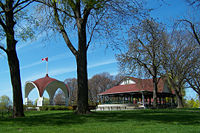
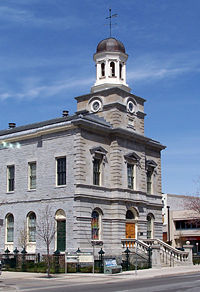
- Montebello Park - Designed by Frederick Law Olmsted in 1887, who went on to create New York City's Central Park. A commemorative rose garden with over 1,300 bushes in 25 varieties is the city's largest rose collection and features an ornamental fountain. The focal point of the park is a band shell and pavilion built in 1888. The park is designated under the Ontario Heritage Act.
- Lakeside Park - Located in the North end, along the shores of Lake Ontario in the community known as Port Dalhousie. Hosts yearly fireworks displays on July 1st (Canada Day). Has picnic areas, a pavilion, snack bar, change rooms, washrooms, playground equipment, boardwalk, the Lakeside Park Carousel, and public docks for visiting boaters. The beach offers magnificent sunset views over Lake Ontario. Lakeside Park inspired a song by Rush which describes the park itself and Neil Peart's memories there.
- Short Hills Provincial Park - Ontario's first provincial park, it is located in the Southwest portion of the city along the Niagara Escarpment.
- Burgoyne Woods - A 50-hectare (0.5 km²) wooded area and recreational park located near the Downtown core.
- Happy Rolph’s Bird Sanctuary - A 6-hectare (0.06 km²) park on the shores of Lake Ontario in the community of Port Weller. It is home to hundreds of native and migratory birds and features an exotic collection of flowering rhododendrons. An onsite petting farm (containing horses, pigs, sheep, goats and llamas, as well as a donkey named 'Hoti' -- 'Don Quixote') is operated by the city from Victoria Day to Thanksgiving Weekend. A trail running throughout the park leads to a peaceful waterfront memorial to Canadian victims of the 9/11 terrorist attacks.
- Ontario Jaycee Gardens - Overlooking the Henley Rowing Course, this is the city's largest horticultural park with more than 8 hectares (0.08 km²) of meticulously landscaped gardens and flower displays. The park exists on land that once featured the Third Welland Canal. The former entrance to the canal can still be seen at the North-West end of the park.
- Walker Arboretum - Located along the hillside of Rodman Hall and the Twelve Mile Creek below, the original owner of this estate was Thomas Rodman Merritt, son of William Hamilton Merritt. In the late 1800s, an English landscape designer named Samuel Richardson was hired by Merritt to tend the grounds. As a result, the arboretum is an extensive, rambling garden with rare conifers which benefit from an exceptional micro-climate. It boasts one of the largest Chinese Empress trees in Canada.
- Woodgale Park - Located along Glendale Avenue between Glenridge Avenue and the Pen Center. Features wide open spaces, flowing fruit trees, rare birds, a soocer field and tennis courts. Also features a memorial to the original farm building on the north end of the park near Denis Morris High school. Locally known as Doug Hill Park, after a nearby resident who coached a number of baseball and tug of war teams in this area.
Government and politics
Municipal
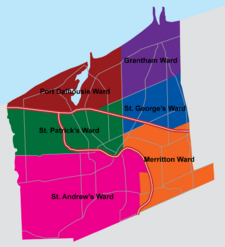
St. Catharines is governed by a mayor and city council of twelve city councillors, with two councillors representing each of the six municipal wards in the city. A city councillor is also elected by the council as a whole to serve as deputy mayor, who only fills the role should the elected mayor not be available. St. Catharines City Council meets every Monday and is open to participation by the community. Matters put forwarded are voted on by members of city council; the mayor presides over council debate and serves very much like the speaker, and as a result only votes in the case of a tie. After 2006, municipal elections will be in November every four years rather than the previous three. Unlike most cities its size, city councillors only serve on a part-time basis and continue with their non-political careers in the community. Only the mayor is elected to a full-time position. St. Catharines City Hall is located downtown on Church Street. Tim Rigby was the Mayor of St. Catharines from 1997 to 2006; Brian McMullan was elected to succeed Rigby on November 13, 2006, and was sworn-in on December 4.
St. Catharines uses a council-manager government, and as a result a Chief Administrative Officer is appointed by council to oversee the day-to-day operations of the city and its departments. The CAO, in effect, is the highest ranking municipal civil servant and has authority over the spending of municipal tax dollars. The CAO advises council on policy matters and acts as liaison between the administrative staff and elected officials. Some of the CAOs duties include assisting in the creation of the municipal budget, and ensuring that municipal funds are spent in a responsible manner. Colin Briggs is Acting CAO, replacing B. Robert Puhach who resigned in February 2007. The city expects to a hire a permanent replacement by Fall 2007.
Residents of St. Catharines also elect six regional councillors to the Niagara Regional Council on an at-large basis. Unlike other Regional Municipalities in Ontario, regional councillors do not sit on city council and instead only represent at the regional level. Four school board trustees for the District School Board of Niagara representing St. Catharines and Niagara-on-the-Lake are elected, as well as and three trustees for the Niagara Catholic District School Board, two for five of St. Catharines' wards, and one for Thorold and the Merriton Ward of St. Catharines. Regional councillors and school board trustees are elected at the same time, and on the same ballot, as the mayor and city councillors.
St. Catharines has one of the highest resident/representative ratios of any large city in Ontario. There are just under 7,000 people per elected municipal representative in St. Catharines, while Oshawa (a similar-sized city in Ontario) has one representative per 13,500 people. London, Ontario has one representative per 30,500 people, and Toronto has one representative per 55,000 people. There has been recent discussion regarding a modification of the city/regional council arrangement, with the possibility of reducing city council to six full-time representatives and having the six regional councillors serve on city council. While there is growing support in the business community for such an arrangement, city council has been unreceptive to such ideas.
Provincial
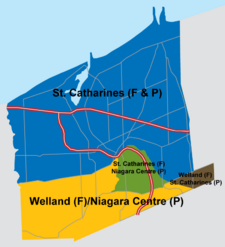
At the provincial level, St. Catharines is well-known for electing high-profile members of the Legislative Assembly of Ontario. Jim Bradley, the current member for St. Catharines and Ontario's longest serving Member of Provincial Parliament, is the current Minister of Tourism in the Liberal government of Dalton McGuinty, and served as Minister of Environment in the government of David Peterson. Jim Bradley recently celebrated 30 years in provincial politics, and it was noted that he actually served in the Ontario Legislature with the parents of five current MPPs.[3] Peter Kormos, who represents the southern portions of the city as part of the Niagara Centre riding, is a prominent vocal member of the Ontario New Democratic Party caucus and served previously as Minister of Justice in the Bob Rae government.
From 1999 to 2003, during the premierships of Mike Harris and Ernie Eves, St. Catharines was one of the few large cities in Ontario to not have at least one government member representing the city, as the Progressive Conservative-held ridings of Lincoln and St. Catharines—Brock were eliminated as a cost saving measure. Robert Welch, a long-time Deputy Premier of Ontario, represented the now-eliminated Lincoln and St. Catharines—Brock ridings throughout the 1960s, 1970s and 1980s.
Federal
Federally, St. Catharines is one of the most bellwether of any riding in Canada, having only elected an opposition MP twice in its history. Rick Dykstra is the current MP for St. Catharines and is a member of the Conservative Party of Canada, which currently forms Canada's government. The southern portion of the city is included as part of the Welland riding, and is represented by John Maloney, a Liberal MP. Most federal representatives from St. Catharines have maintained a low profile on either the government or opposition backbenches. The exception was Gilbert Parent, who served as Speaker of the House for seven years while Jean Chrétien was Prime Minister.
Legal
St. Catharines is the judicial seat of the Niagara North Judicial District of Ontario, Central West Region, which represents the northern half of the Niagara Region equivalent to historic Lincoln County. The Superior Court of Justice is located on Church Street across from City Hall. A satellite court is located in Grimsby. James Ramsey is the current Crown Attorney.
The city forms "1 District" of the Niagara Regional Police Service. The NRPS headquarters are located on Church Street, with administrative offices on James Street and support services on Cushman Road.
Transportation
The most defining transportation icon of St. Catharines is the Welland Canal, a ship canal that runs 43.4 kilometres (27.0 mi), passing through the city. Three of its locks are within city boundaries. The canal allows shipping vessels to traverse the 99.5 metre (326.5 ft) drop in altitude from Lake Erie to Lake Ontario.
The main access routes into and out of St. Catharines are served by two major freeways. The Queen Elizabeth Way runs east (at 15-Mile Creek) to west (at Garden City Skyway) and Highway 406 runs north (at QEW) to south (at St. David's Road). Prior to the construction of these freeways, St. Paul Street (former Highway 8, now Regional Road 81) and Hartzel Road (former Highway 58, now a city-maintained street) provided east-west and north-south access to the city. The QEW is currently undergoing an extensive reconstruction and widening project through the city, which will see it reduced to one lane in both directions for the majority of the construction project. Motorists travelling through St. Catharines are advised to bypass the city, and the Ministry of Transportation has posted special detour signs directing traffic to exit and follow Thorold Stone Road in Niagara Falls through the Thorold Tunnel and back to the QEW via Highway 406. The construction project is expected to be complete by 2012.
Public transportation is served by the St. Catharines Transit Commission, which operates bus routes throughout the city and neighbouring Thorold.
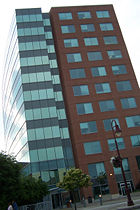
All major routes converge at the St. Catharines Bus Terminal, which is located downtown within the headquarters of the Ontario Ministry of Transportation. The central station is also served by Greyhound Lines and Coach Canada, en route to Toronto and New York City and connecting it to major cities throughout Canada and the United States.
Though transportation by rail is becoming increasingly popular, the St. Catharines train station is largely underutilized, with car and bus travel being the dominant forms of transportation for the city. The station is located in its original building, outside the downtown core (because of issues involving the crossing of 12-Mile Creek). It is served daily by VIA Rail and Amtrak trains connecting it to Toronto and New York City. The provincial and federal government recently committed $385 million each to GO Transit to aid in the development of their 10-Year Capital Expansion Plan, which includes an expansion bus line servicing the Niagara Region. A potential rail link with GO Transit in the near future continues to be debated in St. Catharines.
St. Catharines/Niagara District Airport services general aviation as well as chartered jetliner flights. It is located near the city's east-end in neighbouring Niagara-on-the-Lake.
St. Catharines was the first - and last remaining - location in the world to have a working interurban electric streetcar route, which ran between the city and Merritton and was eventually extended to Port Dalhousie in the north and Thorold to the south. Like most streetcar routes throughout the world, it was decommissioned in the 1960s, and the right-of-way has since been converted to parks and trails.
Education
St. Catharines is home to Brock University (established 1964), a modern comprehensive university located on the Niagara Escarpment. A partnership between the university and the Ontario Grape and Wine Industry established the city as a centre for cool-climate grape and wine research. "Brock" offers an Honours Bachelor of Science in Oenology and Viticulture.
St Catharines is also home to a satellite campus of Niagara College. Niagara College has brought Canada its first Teaching Winery. The "Niagara College Teaching Winery" (or NCT for short) has created award winning wines. Niagara College has also taken home various medals from international wine competitions such as "Cuvee", "The Ontario Wine Awards" and "The Finger Lakes International Competition" to name a few. It is clear why key people in the Wine industry are approaching Niagara College for employees. Niagara College is the only fully licenced teaching winery in Canada.
McMaster University's Michael G. DeGroote School of Medicine is set to open a satellite campus in St. Catharines in September 2008. The Hamilton, Ontario-based university will educate 15 first-year medical students in the city's first-ever med school.
Ridley College, located near the city's downtown core in the Western Hill neighbourhood, is a distinguished co-educational boarding and day school. It was established as a boys' school in 1889, and became co-educational in 1973.
A campus of the Niagara College of Applied Arts and Technology is located near the city's east end. The school's Horticultural Campus was once located on 360 Niagara Street in the 1970s-1990s but has since been relocated to Niagara-on-the-Lake. One of its greatest teachers, R. Roy Forster, was recognized with the Order of Canada on April 14, 1999, for his work in creating the VanDusen Botanical Garden in British Columbia.
The District School Board of Niagara (DSBN), responsible for managing a school system of nearly 119 faculties, contains 8 Secondary Schools in the city of St. Catharines, Kernahan Park, Laura Secord, Sir Winston Churchill, Governor Simcoe, St. Catharines Collegiate, Eden, West Park, and Lakeport.
The Niagara Catholic District School Board (NCDSB) operates 3 Catholic Secondary Schools within the city, Holy Cross, Dennis Morris, and St. Francis.
Communities and development
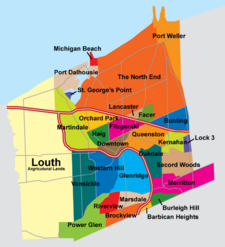
St. Catharines' development history has resulted in a number of unique and distinct communities within the city. The historical area of St. Catharines consisted of nothing more than what is now the downtown core, with the remaining land being part of Louth Township on the west and Grantham Township on the east. St. Catharines continued to steadily grow through the late 19th and early 20th centuries, eventually annexing land to the southwest that would become Western Hill and Old Glenridge, and to the east and north that would collectively become the central part of St. Catharines. In addition to the growth of St. Catharines, the Town of Merritton and the Town of Port Dalhousie existed as separate municipalities to the South and North of the city, each slowly growing their own residential base.

Along with the rest of Ontario, St. Catharines experienced explosive growth after World War II. St. Catharines continued to annex Grantham Township as development continued, including the large swaths of land to the north known now as "The North End". St. Catharines would also absorb Merritton and Port Dalhousie in 1961, making them part of the city. During this time, St. Catharines nearly tripled in population.
With the formation of the Regional Municipality of Niagara in 1970, the portion of Louth Township east of Fifteen Mile Creek was transferred to the City of St. Catharines. This included the eastern portion of the Hamlet of Rockway, as well as the Hamlet of Power Glen. The few remaining portions of Grantham Township in the Northeast corner of the area, including Port Weller, were also transferred to the city. With the new Louth Township lands belonging to the city, St. Catharines would begin two developments in the west end - Martindale in 1983, and Vansickle in 1987. These developments are nearing completion. There was also a push to continue further expansion to the west in the late 1990s, but this has since been halted by Ontario Greenbelt legislation.
The following distinct communities exist within St. Catharines:
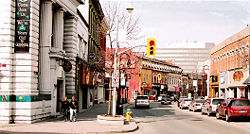
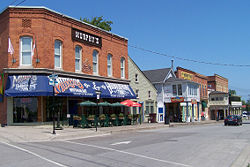
- North
- Bunting
- Facer
- Lancaster
- Michigan Beach
- The North End
- Port Dalhousie
- St. George's Point
- Central
- Fitzgerald
- Haig
- Orchard Park
- Queenston
- Downtown St. Catharines
- West
- Martindale
- Power Glen
- Vansickle
- Western Hill
- East
- Kernahan
- Lock 3
- Merritton
- Oakdale
- Secord Woods
- South
- Barbican Heights
- Brockview
- Burleigh Hill
- Glenridge
- Marsdale
- Riverview
- Louth Agricultural Lands
Demographics
| Ethnic Origin[2] | Population | Percent |
|---|---|---|
| English | 40,430 | 31.09% |
| Scottish | 28,645 | 22.03% |
| Irish | 23,830 | 18.33% |
| German | 18,450 | 14.19% |
| French | 15,120 | 11.63% |
| Italian | 11,205 | 8.61% |
According to the 2006 census, there were 131,989 people residing in city of St. Catharines, located in the province of Ontario, of whom 47.8% were male and 52.2% were female. Minors (youth under the age of 19) totalled 22.6 percent of the population compared to pensioners who number 18.1 percent. This compares with the Canadian average of 24.4 percent (minors) and 13.7 percent (pensioners). The average age of St. Catharines residents is 41.7 compared to the Canadian average of 39.5.[3] In the five years between 2001 and 2006, the population of St. Catharines grew by 2.2%, while Canada as a whole grew by 5.4 percent.
As of 2006, 90.00% of the population was white. Other groups include black: 2.0%, Aboriginal: 1.6%, mixed race: 1.5%, south Asian: 1.3%, and Chinese: 1.1%. Approximately 21 percent of the population was foreign born.[4]
Christianity continues to be the dominant religion of the city. Some 81.0 percent of the population profess a Christian faith, the largest being various Protestant groups (42.9%), followed by Roman Catholicism (34.2%), while the remaining consists of Orthodox, and independent Christian groups. Non-Christian groups are also present, namely Islam (1.5%), Judaism (0.5%), and Buddhism (0.5%). (The city contains a synagogue and Jewish community centre, as well as a large mosque). The remaining 16.5% report other or no religion.
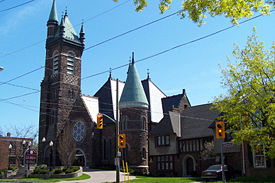
Employment
- Employment rate: 58.2%
- Unemployment rate: 6.5%
- Average earnings: $30,997
Top five employers:
- District School Board of Niagara: 5,000
- General Motors: 2,653
- Niagara Health System: 1,800
- Brock University: 1,324
- Sitel: Approx. 1100
City issues
Like most large Canadian centres, a number of social issues affect the city, and St. Catharines is no exception. Since 1998, St. Catharines has had the highest obesity rates of any centre in Canada. A 2001 analysis by Statistics Canada showed that 57.3 per cent of its residents were overweight.[4] This has caused some elements of the media, including CTV,[4] the Canadian Broadcasting Corporation[5][6] and the Globe and Mail[7] to dub St. Catharines as Canada's "fattest" city. Perhaps not incidentally, St. Catharines had previously appeared in the Guinness Book of World Records as the "Donut Capital of the World." In 2008, new statistics were released that show that the percentage obese or obese/overweight residents of Hamilton (74.3%), Kingston (70.1%), and St. John's, Newfoundland (70%) is now higher than St. Catharines-Niagara (69.3%), though the obesity rate in the city is higher now than in 1998. [5]
St. Catharines also has a chronic shortage of social housing, causing hardship on low-income families.[6]. Downtown St. Catharines also has an unusually high vacancy rate of 10%,[7]causing The Globe and Mail in early 2005 to call St. Catharines the Garbage City.[8] In 2006, many of these issues were brought to the forefront during municipal elections, with the hope that many of these issues can be addressed and changed in the coming years.
Poverty
The median income of $23,400 is the second lowest in Ontario (2004).
Local media
Newspapers
- St. Catharines Standard (daily)
- Niagara This Week (community weekly)
- Pulse Niagara (entertainment weekly)
- The Brock Press (academic)
- St. Catharines Shopping News (commercial advertiser)
Radio
- FM 91.7- (CIXL-FM GIANT-FM) Best of the 80s, 90s and today
- AM 610 - CKTB, news/Talk
- AM 1220 - CHSC, multilingual
- FM 97.7 - CHTZ, active rock
- FM 103.7 - CFBU, Brock University campus radio
- FM 105.7 - CHRE (EZ Rock), adult contemporary
In addition, numerous tourist and travel advisory stations are available off-air in the Niagara area.
Television
The Niagara region has no local television service of its own, although stations broadcasting from Toronto, Hamilton and Buffalo are available. In 2003, a local business consortium applied to the Canadian Radio-television and Telecommunications Commission for a licence to operate TV Niagara, a community television station in St. Catharines. The application was denied by the CRTC in 2005, citing concerns about the group's business plan and its dependence on gaining audience share in the Toronto market. However, the organization has appealed to the Cabinet of Canada and hopes to continue gaining support for local television in Niagara.
Online News
- [http://www.niagarathisweek.com/ Niagara this Week
- Niagara Region Info
- Niagara Sports News
- St. Catharines Standard
Sister cities
Sports and leisure
Lacrosse
St. Catharines is a hotbed for lacrosse, and has had a long history of the sport in the city. The St. Catharines Athletics Jr. A squad, who compete in the Ontario Junior A Lacrosse League, has won six Minto Cup championships (1947, 1950, 1990, 1991, 2001, 2003.) Their senior A squad (now defunct) has also had a great history, winning 14 Major Series Lacrosse championships and five Mann Cup championships (1938, 1940, 1941, 1944, 1946.) The St. Catharines Athletics has brought many successful lacrosse players, many which play in the National Lacrosse League or have had great success before the formation of the NLL in Senior lacrosse leagues. Notable players are:
- Randy Mearns
- Steve Toll
- Craig Conn
- Thomas Hajek
- Pat McCready
- Ian Llord
- Billy Dee Smith
- Sean Greenhalgh
- Matt Vinc
- Mark Steenhuis
The team has also brought successful lacrosse players from other parts of the Niagara Region and many other areas, such as Mike Accursi, Mike Hominuck, Darris Kilgour, and Frank Resetarits. The Athletics play at Bill Burgoyne Arena.
There is also a junior B team in St. Catharines in the Merritton part of town. They are known as St. Catharines Spartans. They have also been successful, winning four league championships and three Founders Cup championships, (only one of them while playing in St. Catharines, in 1996.)
Holy Cross Catholic Secondary School in St. Catharines has one of the most successful high school field lacrosse teams in Canada, which have won three provincial championships and ten SOSSA (Southern Ontario) championships since 1997. The school has produced many successful lacrosse players who have or are currently playing junior, college, and/or professional lacrosse.
Hockey
St. Catharines entered into the Ontario Hockey Association Junior 'A' Hockey in 1943 as the St. Catharines Falcons. In 1947, they became the Teepees and were affiliated with the American Hockey League's Buffalo Bisons. When the National Hockey League's (NHL) Chicago Black Hawks made the Bisons their number one farm team, they inherited the Teepees. In the 1960s, the Jr. 'A' team went deeply into debt to the Chicago Black Hawks, but continued as a successful franchise. The Hamilton Fincups moved to St. Catharines in 1976 and played here for one year before moving back to Hamilton. The AHL St. Catharines Saints played in St. Catharines between 1982 and 1986, before being forced to re-locate to Newmarket due to protests from the NHL Buffalo Sabres. The St. Catharines Saints served as the farm team for the Toronto Maple Leafs, and today are known as the Toronto Marlies.
A new OHL team returned to St. Catharines, in time for the 2007-2008 season [9]. The Niagara IceDogs played out of Jack Gatecliff Arena within the newly named Gatorade Garden City Complex. The city's Junior 'B' Hockey team, appropriately named the St. Catharines Falcons, also plays out of the complex.
Baseball
The city was the home of the New York - Penn League's St. Catharines Blue Jays, the Short-season A affiliate of the Toronto Blue Jays, from 1986 to 1999.
Soccer
The Canadian Soccer League's St. Catharines Wolves are one of the most successful professional soccer teams in Canada, and play at Club Roma in the west-end of the city.
Rowing
Martindale Pond in St. Catharines' Port Dalhousie is the site of the annual Royal Canadian Henley Regatta, a world-class event that brings over 3,000 athletes from various nations to the city. The site hosted the FISA World Rowing Championships in both 1970 and in 1999. There are currently talks to bring the Canadian Rowing Hall of Fame to St. Catharines sometime in the near future. The pond is also home to the St. Catharines rowing club and to the annual CSSRA Championships, which draws hundreds of high school athletes from Canada, the U.S. and Mexico.
Trails system
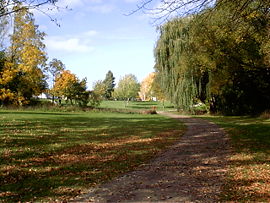
The city's trail system offers over 90 kilometres (55 mi) of accessible pathways that are suitable for walking, jogging, cycling, hiking and cross-country skiing.
- Bruce Trail - Canada's oldest and longest hiking trail, following the Niagara Escarpment (designated as a UNESCO World Biosphere) from Niagara-on-the-Lake to Tobermory. A 20-kilometre (12 mi) section with associated side trails winds through St. Catharines passing by places such as the Morningstar Mill.
- Merritt Trail - a segmented 11 km (6.8 mi) trail that passes many of the old sections of the second Welland Canal and remnants of its locks.
- Terry Fox Fitness Trail - named after Canadian hero Terry Fox, a 1.5 km trail that runs along the former interurban railway right-of-way through central St. Catharines. Placed strategically along the Terry Fox Fitness Trail are six exercise stations of Dynatract Fitness Course, with instruction boards at each station.
- Waterfront Trail - follows the shore of Lake Ontario, connecting communities from Niagara-on-the-Lake to Brockville. The Port Dalhousie portion of the trail is a major highlight.
- Welland Canals Parkway - provides an uninterrupted 9-kilometre (5.6 mi) paved path for non-motorized traffic, along the western-side of the scenic Welland Canal. It links with the waterfront trails of Niagara-on-the-Lake and Port Colbourne, and the Niagara Parkway to create the Greater Niagara Circle Route, measuring approximately 150 kilometres (90 mi). An equestrian trail is located on the east-side of the canal and is part of the parkway.
Whitewater park

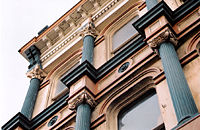

A dedicated group of local paddlers and businesses is trying to bring a Whitewater facility, suitable for hosting world-class kayaking events, to the City of St. Catharines. The proposed course would utilize the Wellandvale stretch of Twelve Mile Creek, near the downtown core. If made reality, the project would be Canada's first urban Whitewater facility.
Plans for the facility were made public in Toronto's bid to host the 2008 Summer Olympic Games. When Toronto lost the bid to Beijing, the Niagara Whitewater Park Association was created to keep the project alive. In September 2006, the St. Catharines Standard[10] reported that St. Catharines Hydro is in talks with Ontario Power Generation to construct a small generating station adjacent to the proposed site of the Whitewater facility. The proposed Shickluna Generating Station would create electricity for up to 5,000 homes while regulating waterflow to the course. Unfortunately the cost of operating the course was found to be aprox. $200,000 per year and the funds could not be found. The proposal has been tabled until an alternative can be found.
Arts and culture
- See also: People from St. Catharines, Ontario
Art Councils
The St. Catharines and Area Arts Council is a not-for-profit organization working to facilitate communication, collaboration and programs among artists, arts organizations and the community with the goal of enhancing cultural life.
Art galleries
Rodman Hall runs a diverse program of exhibitions throughout the year, featuring the work of local, national and international artists. It also houses a permanent collection of over 850 works including paintings, photographs, sculptures and outdoor installations. Rodman Hall was a public-run gallery from 1960-2003 when financial issues provoked Brock University to purchase the building. Today, it is affiliated with the Brock School of Fine and Performing Arts and continues to serve and welcome the public.
The Niagara Artists' Centre (NAC) is a not-for-profit, charitably registered, collective formed by local community artists and dedicated to serving the working artists and art-enthusiasts of Niagara. It runs a series of diverse exhibitions throughout the year involving abstract paintings, sculptures, new media installations and film screenings. Recently, the Niagara Artists' Centre moved out of its former location on Bond St. to a newly renovated storefront building on St. Paul Street in the city's downtown.
Festivals

The Folk Arts Festival was first presented to the city by representatives from the ethno cultural communities of Niagara over 35 years ago. From that first festival was created the Folk Arts Council of St. Catharines, which continues to run its festival each year throughout the month of May and concludes with "Folk Arts in the Park", which takes place in Montebello Park in the city's downtown.
The Art of Peace Festival is now in its fifth year, the Festival seeks to increase community engagement in art as a tool for reflecting on peace issues. Montebello Park fills with performing arts events, Speak Your Peace! open mic program, community art workshops, an elementary school art exhibition, vendors, and Peace Through Art Stations at which peace groups make information available and offer arts activities. This year we are introducing the Youth Listening Tent. Our goals are to increase connections between artists and the public, increase community engagement in peace issues and increase youth engagement. Presented by St. Catharines and Area Arts Council and Project Ploughshares Niagara. The theme of this year’s Festival is Families and Peace. Spend a day in the park – be in touch with the world!
The Niagara Grape & Wine Festival is a non-profit organization that presents three popular wine festivals in St. Catharines and Niagara during the year. The Niagara Icewine Festival (Winter), the Niagara New Vintage Festival (Summer), and the Niagara Wine Festival (Fall), which is the largest of the festivals, attract hundreds of thousands of visitors to the region each year. This event known by most locals simply as "Grape and Wine" attracts young and old varying from partiers to wine connoisseurs.
The SCENE Music Festival is one-day event held in various clubs and pubs downtown. Rock, indie, pop, singer-songwriter, ska, punk, metal, and many other genres are represented by bands such as Alexisonfire, The Strag, White Star Line, Damn 13, Chore, Tangiers, Sick Boys, Raising The Fawn, Supergarage, Sailboats Are White, Revenge Of The Egg People, Bang Theory, and Billy Talent who have played at the festival, which is sponsored by Solo Mobile. Traditionally, a compact disc of select performers is included with admission prices - although in recent years the CD has been expanded to a 2-disc compilation - representative of the growth of the festival.
Museums
The St. Catharines Museum is located at Lock 3 on the Welland Canal, off the Welland Canals Parkway. An elevated viewing platform at the museum allows visitors to get a close-up look at ships from around the world as they climb this major section of the St. Lawrence Seaway. Along with its exhibits dedicated to the city's history and the canals, the museum is home to the Ontario Lacrosse Hall of Fame and Museum.
Morningstar Mill, perched atop the Niagara Escarpment, is one of Ontario's oldest mills on an original site, and is fully powered by water. The picturesque park provides a glimpse into the innovative and pioneering spirit of the 19th Century.
The YMCA Discovery Centre (formerly, The Children's Discovery Centre of Niagara), located in the former Niagara College Horticulture School, provides children and their families with an educational yet entertaining and stimulating place to visit using hands-on, interactive exhibits and outdoor activities.
Musical theatre
Garden City Productions (formerly the Operatic Society of Grantham United Church 1956-1962) puts on two community theatre shows per year at the Mandeville Theatre in Ridley College.
Theatre in Port put on a year-round schedule of professionally produced musicals, comedies and dramas.
Shopping
- The Pen Centre - largest shopping mall in the Niagara Peninsula
- Fairview Mall
- Smart!Centres (formerly First Pro Garden City)
- Lincoln Mall - demolished, replaced by Lincoln Value Centre
- Downtown Farmers Market
- Port Dalhousie Business District
- Merritt Street, South St. Catharines Downtown Merritton
See also
- Downtown St. Catharines, Ontario
- SCENE Music Festival
References
- ↑ p17 of The Refugee, Drew, 1856, available here [1]
- ↑ "Canadian Climate Normals - St. Catharines".
- ↑ St. Catharines Standard - Ontario, CA
- ↑ 4.0 4.1 St. Catharines tops list of Canada's 'fattest' cities. W-Five, July 21, 2001
- ↑ CBC.ca, National Population Health Survey 1998, Statistics Canada
- ↑ CBC.ca, Obese Nation: Statistics, November 8, 2006
- ↑ Fattest & Fittest, St. Catharines leads the fat parade. The Globe and Mail, July 21, 2001
External links
- City of St. Catharines' Official Website
- Niagara Peninsula Communities Website
- Junior 'A' Hockey in St. Catharines - St. Catharines Museum
- Official Town Crier for the City of St. Catharines
- Images from the Niagara Falls Public Library's Historic Digital Collections
- Niagara's Best Beer's Facebook Page
 |
Lake Ontario |
|
|||||
| Lincoln | Niagara-on-the-Lake | ||||||
| Pelham, Thorold |
|
|||||
|
|||||
|
|||||||||||||||||
|
|||||
